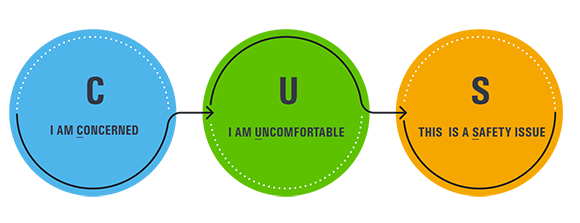If something doesn’t seem right to you, it’s important to raise your concerns, especially when it comes to patient safety. With the CUS tool, you can feel empowered to point out a problem or a conflict of information without challenging the other person’s authority or coming off as a personal attack. Use CUS as an escalation, and say the key words in the acronym: start by stating that you are concerned. If that doesn't work, say that you are uncomfortable. Finally, underscore that this is a safety issue and you need to stop the line.
What is CUS?
See It In Action
Keep this in mind when using CUS....
To give CUS the best chance of success, everyone in the organization should be able to recognize the terms used in CUS and understand how they’re used to escalate concerns. Make speaking up a part of your culture by using your briefs and debriefs to encourage everyone to speak up. A good way to do this is to say to team members at the end:
"Does anyone have any other ideas or concerns?"Is this an effective use of the CUS tool?

Is he using the CUS tool correctly?

Help Crystal escalate her concerns with CUS.
Patients and families should be empowered to speak up and raise concerns about their care using CUS.
Take a moment and educate patients and families on the CUS tool. Instead of it being a "safety issue," it can be changed to "I'm scared." Consider including visual cues of the CUS tool in the spaces that patients and families occupy.
Prepare to Use CUS
It's important to keep in mind that CUS won't always go over well, but that doesn't take away from the critical need to use it to escalate your concerns about a potentially unsafe situation.
Here's how you can prepare for different kinds of scenarios where CUS might not go over well, at least initially.
If your CUS isn't taken seriously, be persistent.
When you bring up a concern to someone, they might shrug it off and not take it seriously. In this case, acknowledge their response, and continue with the CUS model.
Try saying something like:
“I realize you have other patients to check up on, but I’m uncomfortable with how labored the patient’s breathing is. I think you should see her now.”
Prepare for negative reactions to the CUS tool.
When using CUS, it's possible the other person may act dismissive, deny any possibility of wrongdoing or even demean subordinates. In response, continue to escalate your CUS and focus on patient safety.
Try saying something like:
“I hear that you don't think this will be an issue, but I'm uncomfortable with the change in status and need to have some reassurance this won't become a safety issue.”
If that still doesn't work, use your team members to back you up or go up the chain of command.
Be open to the possibility that you're wrong.
The receiver might acknowledge the CUS, and then give an appropriate rationale for their action. Remember, just because you raise a concern with CUS doesn’t necessarily mean you’re in the right. Consider that there could be a rational explanation for something you’ve perceived as a problem or mistake—and if there is, be prepared to move on.
Try saying something like:
"OK, thanks for clarifying. I'm glad we cleared that up."
Invite others to use the CUS tool.
As a leader, you can help people feel comfortable addressing hierarchy concerns by specifically asking them to CUS when they need to. This sets the expectation that you will be receptive to your team's concerns.
Try saying something like:
"OK, thanks for clarifying. I'm glad we cleared that up."
The CUS tool can give you the confidence to speak up when you have a concern, no matter who’s involved.

Want to learn more about Project Firstline?
Contact TeamTraining@aha.org.
We value your feedback. Please complete this brief evaluation.


